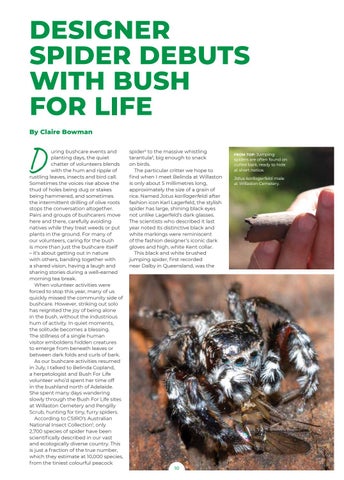DESIGNER SPIDER DEBUTS WITH BUSH FOR LIFE By Claire Bowman
D
uring bushcare events and planting days, the quiet chatter of volunteers blends with the hum and ripple of rustling leaves, insects and bird call. Sometimes the voices rise above the thud of holes being dug or stakes being hammered, and sometimes the intermittent drilling of olive roots stops the conversation altogether. Pairs and groups of bushcarers move here and there, carefully avoiding natives while they treat weeds or put plants in the ground. For many of our volunteers, caring for the bush is more than just the bushcare itself – it’s about getting out in nature with others, banding together with a shared vision, having a laugh and sharing stories during a well-earned morning tea break. When volunteer activities were forced to stop this year, many of us quickly missed the community side of bushcare. However, striking out solo has reignited the joy of being alone in the bush, without the industrious hum of activity. In quiet moments, the solitude becomes a blessing. The stillness of a single human visitor emboldens hidden creatures to emerge from beneath leaves or between dark folds and curls of bark. As our bushcare activities resumed in July, I talked to Belinda Copland, a herpetologist and Bush For Life volunteer who’d spent her time off in the bushland north of Adelaide. She spent many days wandering slowly through the Bush For Life sites at Willaston Cemetery and Pengilly Scrub, hunting for tiny, furry spiders. According to CSIRO's Australian National Insect Collection1, only 2,700 species of spider have been scientifically described in our vast and ecologically diverse country. This is just a fraction of the true number, which they estimate at 10,000 species, from the tiniest colourful peacock
spider2 to the massive whistling tarantula3, big enough to snack on birds. The particular critter we hope to find when I meet Belinda at Willaston is only about 5 millimetres long, approximately the size of a grain of rice. Named Jotus karllagerfeldi after fashion icon Karl Lagerfeld, the stylish spider has large, shining black eyes not unlike Lagerfeld’s dark glasses. The scientists who described it last year noted its distinctive black and white markings were reminiscent of the fashion designer’s iconic dark gloves and high, white Kent collar. This black and white brushed jumping spider, first recorded near Dalby in Queensland, was the
10
FROM TOP: Jumping spiders are often found on curled bark, ready to hide at short notice.
Jotus karllagerfeldi male at Willaston Cemetery.








